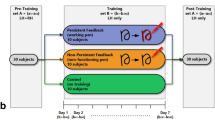Abstract
Adaptation to a novel visuo-motor gain has been found to generalize across target directions, whereas simultaneous adaptation to different direction-related visuo-motor gains turned out to be impossible. We ask whether this is a rigid constraint on human adaptability or a soft constraint that can be overcome by optimized conditions of practice. In particular, we compared practice with continuous visual feedback, as used in previous studies, to practice with terminal visual feedback. With terminal visual feedback only the final positions of the movements are shown. Both kinds of visual feedback in principle can serve the acquisition of an internal model of direction-related visuo-motor gains, but with continuous feedback on-line visual closed-loop control permits accurate movements without access to an internal model. Whereas we found no indication of visuo-motor adaptation after continuous-feedback practice, there was adaptation after terminal-feedback practice. This was revealed both by (direction-related) adaptive shifts of movement amplitudes in an open-loop test with cued visuo-motor transformation and by (direction-related) aftereffects in an open-loop test with absence of the visuo-motor transformation being cued. None of the two groups gave evidence of explicit knowledge of the direction-related visuo-motor gains. These findings show that constraints on human adaptability can depend on the kind of experience with visuo-motor transformations, in particular on the kind of feedback during practice.




Similar content being viewed by others
Notes
Typical measures in studies of adaptation to novel visuo-motor transformations are errors, which are gradually reduced in the course of practice, and aftereffects, which can be observed in the absence of the transformation. Aftereffects are “negative” relative to the errors that are induced by the transformation. Measures of adaptive changes, as we use them, are uncommon. They are equivalent to aftereffects in that they are “negative.” Aftereffects can be conceived as components of adaptive changes which persist in spite of the knowledge that the novel visuo-motor transformation is no longer in effect. Both adaptive changes and aftereffects are direct measures of the changes of the movements produced rather than of the effects of these changes on the output of the visuo-motor transformation. Nevertheless, adaptive changes can also be expressed in terms of cursor amplitude: for a given visuo-motor gain they are proportional to the difference between post-test amplitude and baseline-test amplitude multiplied by the gain. This again is the difference between post-test amplitude and the expected post-test amplitude in the absence of any adjustment to the novel visuo-motor gain.
References
Bedford FL (1989) Constraints on learning new mappings between perceptual dimensions. J Exp Psychol Hum Percept Perform 15:232–248
Bedford FL (1993) Perceptual and cognitive spatial learning. J Exp Psychol Hum Percept Perform 19:517–530
Bedford FL (1995) Constraints on perceptual learning: objects and dimensions. Cognition 54:253–297
Bernier P-M, Chua R, Franks IM (2005) Is proprioception calibrated during visually guided movements? Exp Brain Res 167:292–296
Bock O (1992) Adaptation of aimed arm movements to sensory-motor discordance: evidence for direction-independent gain control. Behav Brain Res 51:41–50
Canon LK (1970) Intermodality inconsistency of input and directed attention as determinants of the nature of adaptation. J Exp Psychol 84:141–147
Canon LK (1971) Directed attention and maladaptive “adaptation” to displacement of the visual field. J Exp Psychol 88:403–408
Clower DM, Boussaoud D (2000) Selective use of perceptual recalibration versus visuomotor skill acquisition. J Neurophysiol 84:2703–2708
Cohen MM (1967) Continuous versus terminal visual feedback in prism aftereffects. Percept Mot Skills 24:1295–1302
Cohen MM (1974) Changes in auditory localization following prismatic exposure under continuous and terminal visual feedback. Percept Mot Skills 38:1202
Davidson PR, Jones RD, Sirisena HR, Andreae JH (2000) Detection of adaptive inverse models in the human motor system. Hum Mov Sci 19:761–795
Flanagan JR, Rao A (1995) Trajectory adaptation to a nonlinear visuomotor transformation: evidence of motion planning in visually perceived space. J Neurophysiol 74:2174–2178
Frensch PA, Haider H, Rünger D, Neugebauer U, Voigt S, Werg J (2002) Verbal report of incidentally experienced environmental regularity: the route from implicit learning to verbal expression of what has been learned. In: Jiménez L (ed) Attention and implicit learning. Benjamins, New York, pp 335–366
Goodbody SJ, Wolpert M (1999) The effect of visuomotor displacements on arm movement paths. Exp Brain Res 127:213–223
Gordon J, Ghilardi MF, Ghez C (1994) Accuracy of planar reaching movements. I. Independence of direction and extent variability. Exp Brain Res 99:97–111
Haider H, Frensch PA (2005) The generation of conscious awareness in an incidental learning situation. Psychol Res 69:399–411
Heuer H, Hegele M (2007) Learning new visuo-motor gains at early and late working age. Ergonomics 50:979–1003
Heuer H, Hegele M (in press) Adaptation to a nonlinear visuo-motor amplitude transformation with continuous and terminal visual feedback. J Mot Behav
Heuer H, Sangals J (1998) Task-dependent mixtures of coordinate systems in visuo-motor transformations. Exp Brain Res 119:224–236
Jordan MI (1996) Computational aspects of motor control and learning. In: Heuer H, Keele SW (eds) Handbook of perception and action, vol 2: motor skills. Academic, London, pp 71–120
Kelso JAS, Cook E, Olson ME, Epstein W (1975) Allocation of attention and the locus of adaptation to displaced vision. J Exp Psychol Hum Percept Perform 1:237–245
Krakauer JW, Ghilardi MF, Mentis M, Barnes A, Veytsman M, Eidelberg D, Ghez C (2004) Differential cortical and subcortical activations in learning rotations and gains for reaching: a PET study. J Neurophysiol 91:924–933
Krakauer JW, Pine ZM, Ghilardi MF, Ghez C (2000) Learning of visuomotor transformations for vectorial planning of reaching trajectories. J Neurosci 20:8916–8924
Proteau L, Isabelle G (2002) On the role of visual afferent information for the control of aiming movements toward targets of different sizes. J Mot Behav 34:367–384
Proteau L, Marteniuk RG, Lévesque L (1992) A sensorimotor basis for motor learning: evidence indicating specificity of practice. Q J Exp Psychol 44A:557–575
Proteau L, Marteniuk RG, Girouard Y, Dugas C (1987) On the type of information used to control and learn an aiming movement after moderate and extensive training. Hum Mov Sci 6:181–199
Redding GM, Wallace B (1990) Effects on prism adaptation of duration and timing of visual feedback during pointing. J Mot Behav 22:209–224
Rossetti Y, Desmurget M, Prablanc C (1995) Vector coding of movement: vision, proprioception, or both? J Neurophysiol 74:457–463
Smeets JBJ, van den Dobbelsteen JJ, de Grave DDJ, van Beers MJ, Brenner E (2006) Sensory integration does not lead to sensory calibration. Proc Natl Acad Sci 103:18781–18786
Uhlarik J, Canon L (1971) Influences of concurrent and terminal exposure conditions on the nature of perceptual adaptation. J Exp Psychol 91:233–239
Vindras P, Desmurget P, Viviani P (2005) Error parsing in visuomotor pointing reveals independent processing of amplitude and direction. J Neurophysiol 94:1212–1224
Vindras P, Viviani P (1998) Frames of reference and control parameters in visuomanual pointing. J Exp Psychol Hum Percept Perform 24:569–591
Vindras P, Viviani P (2002) Altering the visuomotor gain. Evidence that motor plans deal with vector quantities. Exp Brain Res 147:280–295
Welch RB (1972) The effect of experienced limb identity upon adaptation to simulated displacement of the visual field. Percept Psychophys 12:453–456
Welch RB (1978) Perceptual modification. Adapting to altered sensory environments. Academic, New York
Wolpert DM, Ghahramani Z, Jordan MI (1995) Are arm trajectories planned in kinematic or dynamic coordinates? An adaptation study. Exp Brain Res 103:460–470
Acknowledgments
The research reported in this paper was supported by grant He 1187/15-1 of the Deutsche Forschungsgmeinschaft. We thank Barbara Herbst, Thorsten Klar, Steven Li, and Eckhard Rückemann for their support in setting up and running the experiment, and Digby Elliott and an anonymous reviewer for their helpful comments on an earlier version of the ms.
Author information
Authors and Affiliations
Corresponding author
Rights and permissions
About this article
Cite this article
Heuer, H., Hegele, M. Constraints on visuo-motor adaptation depend on the type of visual feedback during practice. Exp Brain Res 185, 101–110 (2008). https://doi.org/10.1007/s00221-007-1135-5
Received:
Accepted:
Published:
Issue Date:
DOI: https://doi.org/10.1007/s00221-007-1135-5




